This Term Applies to the Lineage (Family) of Both Arabs and Jews.
| Arabs (عرب) | |||||||||||||||||||||||||||||||||||||||||||||||||||||||||
|---|---|---|---|---|---|---|---|---|---|---|---|---|---|---|---|---|---|---|---|---|---|---|---|---|---|---|---|---|---|---|---|---|---|---|---|---|---|---|---|---|---|---|---|---|---|---|---|---|---|---|---|---|---|---|---|---|---|
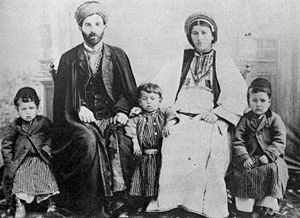 | |||||||||||||||||||||||||||||||||||||||||||||||||||||||||
| Total population | |||||||||||||||||||||||||||||||||||||||||||||||||||||||||
| c. 420–450 million[1] | |||||||||||||||||||||||||||||||||||||||||||||||||||||||||
| Regions with significant populations | |||||||||||||||||||||||||||||||||||||||||||||||||||||||||
| |||||||||||||||||||||||||||||||||||||||||||||||||||||||||
| Languages | |||||||||||||||||||||||||||||||||||||||||||||||||||||||||
| Arabic | |||||||||||||||||||||||||||||||||||||||||||||||||||||||||
| Religions | |||||||||||||||||||||||||||||||||||||||||||||||||||||||||
| Predominantly Muslim. There are also some adherents of Christianity, Druze, Judaism, Samaritan, Yazidi or others. | |||||||||||||||||||||||||||||||||||||||||||||||||||||||||
| Related ethnic groups | |||||||||||||||||||||||||||||||||||||||||||||||||||||||||
| various Afro-Asiatic peoples |
The term Arab (Arabic: عربʻarab) generally refers to those persons who speak Arabic as their native tongue. There are estimated to be over 300 million people living in the Arab globe. In that location are 22 nations holding membership in the Arab League, though non all are independent. Arabs form the majority of the populations of Algeria, Bahrain, Egypt, Iraq, Jordan, Kuwait, Lebanon, Libya, Morocco, Oman, Qatar, Saudi Arabia, Sudan, Syria, Tunisia, the United Arab Emirates, and Yemen. Somalia, Djibouti, Mauritania, Comoros, and the state of Palestine are as well included in the Arab League, although Arabs are not necessarily the bulk of all their populations.
The Arab globe should non be confused with the term "Heart East," which is a strategic designation birthed during the days of the British Empire, and encompasses such non-Arab countries as State of israel, Islamic republic of iran, and Turkey.
An overwhelming majority of Arabs are Muslim, members of the faith founded by the Prophet Muhammad in the seventh century. There are also Standard arabic-speaking Jews and Christians throughout the Middle Due east. Nonetheless, though Arab history is closely intertwined with Muslim history, there are significant not-Muslim communities in the Arab earth. Too, many Muslims are from not-Arab countries such every bit Turkey, Pakistan, Indonesia and many Sub-Saharan African countries. There are likewise big Arab and not-Arab Muslim communities in North America.
Contents
- 1 Origin
- 1.1 Pure origin
- 1.2 Arabized Arabs
- 2 "Defining" an "Arab"
- 3 History
- 3.1 Southern Arabia
- three.2 Northern Arabia
- three.3 Accelerate of Islam
- 4 Religions
- five Language
- six Culture
- 6.1 Music
- 7 Notes
- 8 References
- 9 External links
- 10 Credits
Geographically, the Arab world is defined as extending from the Persian Gulf to the Atlantic Ocean, from Iraq and the Gulf states in the eastward to Kingdom of morocco'southward Atlantic coast in the w. From north to southward, the Arab world extends from Syria to Sudan.
In that location are several means to exist considered an Arab. One is past lineage, considered to be "pure Arab," which can exist traced as far back as Noah through his son Shem. Another group, considered to exist "Arabized-Arabs," come up from Due north African or Heart Eastern countries outside the Arabian Peninsula. This group includes anyone who speaks Arabic, follows Standard arabic traditions, and is loyal to Standard arabic politics.
Origin
The Arabs of the Arabian Peninsula, the surface area of country between Asia and Africa, commonly believe that they are descendants of Shem, the son of Noah.
Keeping the surname is an important part of Arabic culture as some lineages can be traced far back to ancient times. Some Arabs claim they can trace their lineage directly back to Adam. In addition to Noah and Shem, some of the first known Arabs are those who came from Petra, the Nabataean capital (today, Petra is an archaeological site in Jordan, lying in a basin among the mountains which form the eastern flank of Wadi Araba).
Other Arabs are known equally "Arabized-Arabs," including those who came from some parts of Mesopotamia, the Levant, Berber lands, Moors, Egypt, The Sudan, and other African Arabs. Arab-origin is divided into two major groups, 'pure' and 'Arabized.'
Pure origin
Those considered 'pure' Arabs are those known as Qahtanite who are traditionally considered to be direct descendants of Noah through his son Shem, through his sons Aram and Arfakhshaath. Famous noble Qahtanite Arab families from this group can be recognized in the mod days from their surnames such as: Alqahtani, Alharbi, Alzahrani, Alghamedey, aws and khazraj (Alansari or Ansar), Aldosari, Alkhoza'a, Morra, Alojman, etc. Arab genealogies usually accredit the origins of the Qahtanites to the Due south Arabians who congenital up 1 of the oldest centers of culture in the Well-nigh East get-go effectually 800 B.C.Eastward. These groups did not speak one of the early forms of Arabic language or its predecessors, however they did speak such South Semitic languages every bit Sabaic, Minaic, Qatabanic, and Hadramitic.[12]
Arabized Arabs
The term "Arabized-Arabs" can be used in 3 different cases:
- It is used for defining the Arabs who are traditionally considered to be descendants of Abraham through his son Ishmael through his son Adnan, and they are known as Adnanite; Abraham took his Egyptian wife Hagar (or Hajar) and his son Ishmael to Mecca. Ishmael was raised by his mother Hagar and one noble Arab family unit who departed from Republic of yemen and settled in Mecca post-obit the drought in Yemen. Ishmael learned the Arabic language and he spoke it fluently during his life, thus the primary reason for calling this group Arabized. It is believed likewise that the Prophet of Islam Muhammad is descended of Adnanite Arab. Some famous noble Adnanite Arab families from this grouping are: Alanazi, Altamimi, Almaleek, Bani khaled, Bani kolab, Bani Hashim, etc.
- The term Arabized-Arabs is also used for defining the Arabs who spoke other Afro-Asiatic languages. They are Arabic speakers and are regarded as Arabs in contemporary times.
- The same term al-Musta'ribah or "Arabized-Arabs" is besides used for the "Mixed Arabs," between "Pure Arabs" and the Arabs from South Arabia.
"Defining" an "Arab"
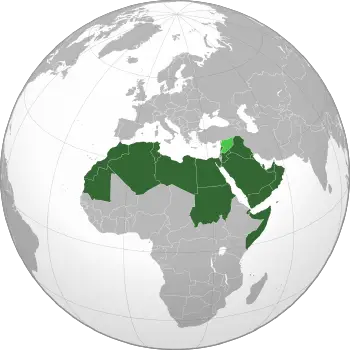
Orthographic projection of the Arab League. The Syrian Arab Republic was suspended in November 2011, and then it is shaded a lighter greenish.
The term 'Arab' has had a wide multifariousness of uses over the centuries. Throughout history, the Arabian Peninsula has been traditionally called 'Arabia.' This was particularly truthful during Greek, Roman, Persian, and Byzantine eras. At times Roman historians would refer to Arab rulers as "King of the Arabs." The use of this term has often proven disruptive to the mod historians, who attempt to ascertain the term according to modern history. [xiii]
Modern Arab nationalism is a product of nineteenth and twentieth century transformations. Prior to this time, virtually Arabic-speakers identified themselves with a item family or tribe. Prior to the twentieth century, the term "Arab" designated the bedouin, tribal-based society of the Arabian Desert, which is the birthplace of the Arabic linguistic communication.[fourteen]
On its formation in 1946, the Arab League defined an "Arab" equally follows;
"An Arab is a person whose language is Standard arabic, who lives in an Arabic speaking state, who is in sympathy with the aspirations of the Arabic speaking peoples."[xv]
Similarly, according to Habib Hassan Touma, a Palestinian composer, "An 'Arab', in the modern sense of the word, is one who is a national of an Arab state, has command of the Arabic language, and possesses a fundamental knowledge of Arabian tradition, that is, of the manners, customs, and political and social systems of the culture."
The fourteenth century Islamic scholar Ibn Khaldun, did not utilise the word Arab to refer to the Arab people every bit divers by any of those definitions; just only to those standing to alive a bedouin (nomadic) life.
These are the varied definitions commonly accepted in determining "Arab" status:
- Islamic tradition: The Qur'an does not define who is an Arab, only there is a verse in the Qur'an stating "in that location is no difference between an Arab or Ajam (significant a non-Arab speaker), only past their god-fearingness." The prophet Muhammad also noted that an Arab is anyone who speaks Arabic.
- Ethnic identity: someone who considers him or herself to be an Arab (regardless of racial or ethnic origin) and is recognized as such past others.
- Race: The term "Arab" does not refer to a particular race. Arabs include Caucasians and Africans with ancestral origins in Europe, North Africa, and the Middle East. The intermarriage of Arab seamen and their agents as far back as the first century [16] has left few 'pure' Arabs, racially. "Night skinned" Arabs are Sudanese, Ethiopian and Somalian Arabs, and Arabs from Southern Egypt who are considered Africans. "Caucasian" Arabs are Arabs native to Syria, Lebanon, Palestine, Tunisia, Algeria, and Libya among others.
- Linguistic: someone whose starting time language is Standard arabic (including whatsoever of its varieties); this definition covers more than 250 million people. Arabic belongs to the Semitic family of languages.
- Genealogical: someone who tin trace his or her beginnings back to the original inhabitants of the Arabian Peninsula or the Syrian Desert.
Arab nationalism declares that Arabs are united in a shared history, civilisation and language. Arab nationalists believe that Arab identity encompasses more than than outward concrete characteristics, race or religion. A related credo, Pan-Arabism, calls for all Arab lands to exist united as i state. Arab nationalism has often competed for existence with regional and ethnic nationalisms in the Middle East, such as Lebanese and Egyptian.
History
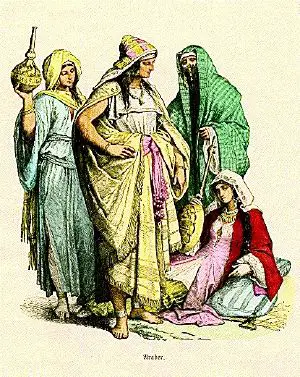
Wearing apparel of Arab women, quaternary to 6th century
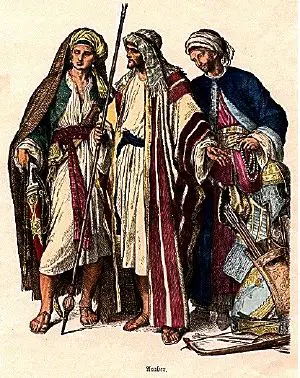
Dress of Arab men, 4th to sixth century
The Semitic peoples (those speaking Semitic languages), who trace their origins to the Arabian Peninsula, have had unprecedented influence on the world since recorded history. They are responsible for the first civilizations and a set up of cultural practices that have been globalized to a larger extent than whatever other culture, including those of Mainland china and Europe. Three major globe religions, the Abrahamic faiths of Judaism, Christianity and Islam, have sprung from them. These people had their beginnings on the Arabian Peninsula, merely the near influential cultures and civilizations of early event are attributed to those who left the peninsula for Mesopotamia, Palestine, and Africa.
Historically, there take been three major instances of transformation and growth within the Arab world:
- the growth of Semitic civilizations in Mesopotamia iv one thousand years ago
- the spread of Christianity and Judaism two grand years ago
- the emergence of Islam fifteen hundred years agone.
Southern Arabia
A sedentary mode of life emerged among the Sabaeans (too known every bit Himyarites or Yemenites) in the lush climate of southern Arabia. This surface area was ruled through a city-states organisation by priest kings, just by the first millennium C.E., this had given way to a secular monarchy.
There were four major city-states inside this area; the Saba' (Sabaeans), Hadramawt, Qataban, and Ma'in. These groups did not form a political or indigenous unity amid themselves. Instead the Saba' grew to be the most powerful, eventually expanding its political influence to include all the major kingdoms of the south by 300 C.E.
The wealth of the Saba' territory was legendary throughout the Fertile Crescent and Northern Africa. Its luxury goods, exotic plants and spices commanded high prices in trade throughout the Mediterranean and Asia. Ii major merchandise routes ran through this expanse; an ocean-trading route between Africa and India and a country-based merchandise route that ran upward and down the coast of the peninsula. Major cities grew up along this route, one of them, Mecca was afterwards the birthplace of Islam.
By the seventh century C.E., this southern area had fallen into political disarray. Long protected from invasion by a wall of mountains on one side and the ocean on the other, it somewhen came to the attention of those who would not exist deterred by such obstacles. Judaizing and Christianizing forces began to vie for the area.
Northern Arabia
Ethnically 1 people, the northern Arabs were equanimous of ii culturally differing peoples; nomadic and sedentary Arabs.
A much harsher environment than in the south, a nomadic tribal existence was necessary. Agriculture was not possible; pastoralism was. These pastoral nomadic peoples came to be known as the Bedouins. These small tightly-knit tribes moved their herds from identify to place in search of deficient resources and water.
A number of Bedouin tribes settled around the oases that surround the periphery of the Arabian Desert. Control of these areas came through armed services campaigns. These Bedouins were unable to seize possession of these areas until more than powerful political rivals, such as Mesopotamia and the Sabaeans, had get weaker or more than diffuse. Information technology was not until the kickoff millennium that many of the major sedentary Arab settlements were established, and then by the fourth dimension of Islam, the culture of sedentary Arabs was still very close to that of their nomadic cousins.
These settlements were on the land routes connecting Africa and India with the Mediterranean world. As such the sedentary Arabs became trade intermediaries, bringing them power and prosperity.
This grouping experienced 3 singled-out historical periods prior to the advent of Islam.
- The first period began with the refuse of the Greek Seleucids in the Middle East likewise as of the southern Sabaeans.
- The second period began with the expansion of Roman, then Byzantine, and then Sabaean power and was the menstruum of client-states. The Arab cities became client to three major earth powers: the Byzantine empire in the north, the Persians in the east, and the southern Arabic kingdom of Himyar (the Sabaeans). Christianity and Judaism spread chop-chop during this time.
- The third period concerned inner Arabia, peculiarly the urban center of Mecca. This was a great period of flowering and prosperity of Bedouin culture and military machine power. The Bedouins closely centrolineal themselves with the central Arabian cities, such as Medina (Yathrib) and Mecca. At this time classical Arabic became the language of culture and poetry. This catamenia saw the diffusion of Bedouin values and the widespread diffusion of Bedouin narratives and poesy.
Advance of Islam
During the eighth and ninth centuries, the Arabs (specifically the Umayyads, and after Abbasids) forged an empire whose borders touched southern France in the west, China in the due east, Asia Pocket-sized in the north, and the Sudan in the south. This was one of the largest land empires in history. Throughout much of this area, the Arabs spread the faith of Islam and the Standard arabic language (the language of the Qur'an) through conversion and cultural assimilation. Many groups came to be known as "Arabs" non through descent simply through this process of Arabization. Thus, over time, the term Arab came to carry a broader pregnant than the original indigenous term: cultural Arab vs. indigenous Arab. People in Sudan, Egypt, Kingdom of morocco, People's democratic republic of algeria and elsewhere became Arab through Arabization.
Religions
Today, the majority of Arabs are Muslim with sizable followers of both Christianity and Judaism. Arab Muslims are Sunni, Shiite, Ibadhite, Alawite, Ismaili, or Druze. The Druze faith is sometimes considered as a religion apart. Arab Christians follow generally one of the following Eastern Churches: Coptic, Maronite, Greek Orthodox, Greek Catholic, or Chaldean.
Earlier the coming of Islam, most Arabs followed a religion featuring the worship of a number of deities, including Hubal, Wadd, Al-Lat, Manat, and Uzza, while some tribes had converted to Christianity or Judaism, and a few individuals, the hanifs, had obviously rejected polytheism in favor of a vague monotheism. The most prominent Arab Christian kingdoms were the Ghassanid and Lakhmid kingdoms. With the conversion of the Himyarite kings to Judaism in the late fourth century, the elites of the other prominent Arab kingdom, the Kindites, existence Himyirite vassals, announced to take converted (at to the lowest degree partly) to Judaism too. With the expansion of Islam, the bulk of Arabs speedily became Muslims, and the pre-Islamic polytheistic traditions disappeared.
Sunni Islam dominates in almost areas, overwhelmingly and then in Northward Africa; Shia Islam is prevalent in Bahrain, southern Iraq and adjacent parts of Saudi Arabia, southern Lebanese republic, parts of Syrian arab republic, and northern Yemen. The tiny Druze community, belonging to a secretive offshoot of Islam, is usually considered Arab, merely sometimes considered an ethnicity in its own right.
Reliable estimates of the number of Arab Christians, which in any case depends on the definition of "Arab" used, vary. Today Christians brand up less than x percent of the population of the Nearly East.
Jews from Arab countries - mainly Mizrahi Jews and Yemenite Jews - are today unremarkably not categorized as Arab. Sociologist Philip Mendes asserts that before the anti-Jewish actions of the 1930s and 1940s, overall Iraqi Jews viewed themselves as Arabs of the Jewish faith, rather than as a split up race or nationality. Prior to the emergence of the term Mizrahi, the term "Arab Jews" (Yehudim 'Áravim, יהודים ערבים) was sometimes used to draw Jews of the Arab world. The term is rarely used today. The few remaining Jews in the Arab countries reside mostly in Morocco and Tunisia. Between the late 1940s and early 1960s, post-obit the creation of the State of State of israel, most of these Jews left or were expelled from their countries of nascency and are at present mostly concentrated in Israel. Some also immigrated to French republic where they course the largest Jewish customs, outnumbering Ashkenazi Jews, or European Jews, but relatively few to the United States.
"Arab Jews" is a term occasionally used for Mizrahim Jews originating in Arab lands. Considering of political tensions stemming from the Arab-Israeli conflict, few Mizrahim now identify themselves as "Arabs" or "Arab Jews." At nowadays the term is mainly used by official and journalistic sources in the Arab earth, but information technology has been reclaimed by some Mizrahi activists.
Local Yemenite Jewish traditions trace the earliest settlement of Jews in this region back to the time of Male monarch Solomon. At that place are numerous legends placing Jews in ancient Yemen sent by King Solomon, the Queen of Sheba and even the Prophet Jeremiah. These "Yemeni Jews" are also Jews of Arab-origin.
Language
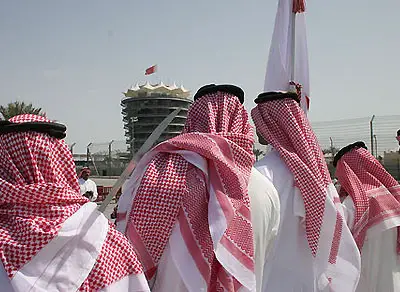
Arab men in Bahrain, 2007
Arabic is the largest fellow member of the branch of the Afro-Asiatic language family and is closely related to Hebrew, Amharic, and Aramaic. It is spoken throughout the Arab globe and is widely studied and known throughout the Islamic globe.
Classical Arabic has been a literary language since at least the sixth century and is the liturgical language of Islam. Modern Standard Standard arabic derives from Classical Standard arabic. Because of its liturgical part, Arabic has lent many words to other Islamic languages, akin to the role Latin has in Western European languages. During the Middle Ages Arabic was as well a major vehicle of civilization, especially in science, mathematics and philosophy, with the issue that many European languages have likewise borrowed numerous words from it. The Arabic script is written from right to left.
"Colloquial Arabic" is a collective term for the spoken languages or dialects of people throughout the Arab world, which can differ radically from the literary linguistic communication. The main dialectal sectionalisation is between the North African dialects and those of the Middle Eastward, followed by that betwixt sedentary dialects and the much more conservative Bedouin dialects. Speakers of some of these dialects are unable to converse with speakers of another dialect of Arabic; in particular, while Eye Easterners can mostly empathize 1 another, they often have trouble understanding North Africans (although the converse is not true, due to the popularity of Middle Eastern, peculiarly Egyptian, films and other media).
The Arabic alphabet derives from the Aramaic script (Nabataean), to which it bears a loose resemblance like that of Coptic or Cyrillic script to Greek script. Traditionally, there were several differences between the Western (North African) and Middle Eastern version of the alphabet. After the definitive fixing of the Arabic script around 786, by Khalil ibn Ahmad al Farahidi, many styles were developed, both for the writing down of the Qur'an and other books, and for inscriptions on monuments as ornament.
Standard arabic calligraphy has non fallen out of employ as in the Western globe, and is nonetheless considered by Arabs as a major art course; calligraphers are held in great esteem. Existence cursive by nature, unlike the Latin alphabet, Arabic script is used to write downward a verse of the Qur'an, a Hadith, or simply a proverb, in a spectacular limerick.
Culture
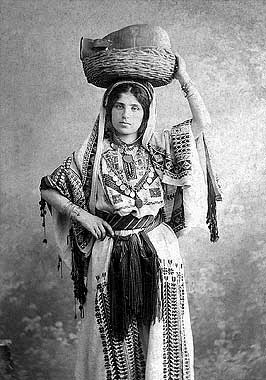
Arab woman from Ramallah wearing traditional dress, 1915
Much of the Arab world is characterized by a lack of clear separation between religious doctrine and social life. The teachings and instance of the Prophet Muhammad'south life tend to be used as a measurement in judging the bear of both public officials and individual individuals. Almost modern Arab states have established ceremonious codes which govern public affairs but Islamic canon law, the Sharia, remains of great importance, particularly in domestic matters such as union, divorce and inheritance.
Family honor is of great importance in the Arab world, and the obligations and responsibilities of kinship are not easily ignored. The chastity of women and obedience of children are matters of concern to all kinspeople as well equally to husbands and wives. 'Honor killings' have taken identify when a female family member was deemed to have acted inappropriately according to expected standards.[17] Hospitality and generosity to guests is a source of pride, while assistance from kinsfolk in any crunch remains an expectation at all levels of Arab society.
In the past, urban women were encouraged to remain in the home equally much as possible, while a 'virtuous' woman was expected to habiliment veils and concealing outer garments. In recent years this is not universally practiced, although vestiges of this outlook remain in certain areas of the Arab world.
Flowing robes, capes and head-cloths traditionally regarded as male dress are all the same worn in many of the Arab lands. Many men, even so wear Western fashion wearable.[18]
Music
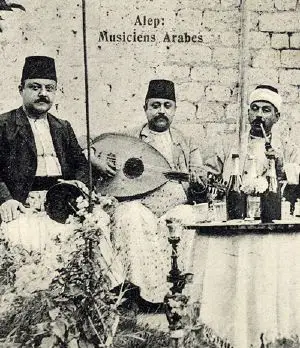
A vital aspect in the Arab life is music. Nomadic encampments in ancient times utilized music to gloat every event in life. It served such purposes as inciting warriors, encouraging desert travelers, embellishing social meetings, and even calling the pilgrims to the blackness stone of the Ka'bah (in Mecca), a holy shrine even in pre-Islamic times. Periodic poesy competitions and musical performances were held in the marketplace places, while in the king's entourage musicians occupied high rank. In the Mazdak sect (a dualistic Farsi religion related to Manichaeanism) music was considered to be 1 of the four spiritual powers.
Arabic music has been influenced by many varying cultures, such equally Ancient Greek, Western farsi, Turkish, Indian, African (such as Berber and Swahili) likewise as European. Every bit in other fine art and scientific discipline fields, the Arabs translated and developed Greek texts and works of music and mastered the music theory of the Greeks. The common way that adult is usually chosen 'Islamic' or 'Arab', though in fact it transcends religious, indigenous, geographical, and linguistic boundaries," and it has been suggested that information technology be called the "Nigh East style" (from Morocco to India).[xix]
The world of modern Arabic music has long been dominated by musical trends that have emerged from Cairo, Egypt. The metropolis is generally considered a cultural center in the Arab earth. Innovations in pop music via the influence of other regional styles have likewise abounded from Morocco to Saudi arabia. In contempo years, Beirut has get a major heart, dictating trends in the development of Arabic pop music. Other regional styles that have enjoyed popular music status throughout the Arab world include the Algerian raï, the Moroccan Gnawa, the Kuwaiti sawt, the Egyptian el gil and Turkish Arabesque-popular music.
Arabic religious music includes Christian and Islamic music. However, Islamic music, including the singing of Qur'an readings, is structurally equivalent to Arabic secular music, while Christian Arab music has been influenced by Catholic, Greek Orthodox, Anglican, Coptic, and Maronite church music.
Notes
- ↑ Margaret Kleffner Nydell, Agreement Arabs: A Guide For Modern Times (Nicholas Brealey, 2018, ISBN 1473669979).
- ↑ Silvia Ferabolli, Arab Regionalism: A Mail-Structural Perspective (Routledge, 2014, ISBN 1138787809).
- ↑ To count or not to count The Economist, March 26, 2009. Retrieved September 23, 2021.
- ↑ Omer Karasapan, Turkey's Syrian refugees—the welcome fades Brookings Establish, November 25, 2019. Retrieved September 23, 2021.
- ↑ Bevölkerung und Erwerbstätigkeit Statistisches Bundesamt, April 12, 2018. Retrieved September 23, 2021.
- ↑ Demographics Arab American Plant. Retrieved September 23, 2021.
- ↑ 65th Independence Day – More than eight Meg Residents in the Land of Israel Key Agency of Statistics. Retrieved September 23, 2021.
- ↑ Mac Margolis, Abdel el-Zabayar: From Parliament to the Frontlines The Daily Beast, September 15, 2013. Retrieved September 23, 2021.
- ↑ Habeeb Salloum, Arabs Making Their Mark in Latin America: Generations of Immigrants in Republic of colombia, Venezuela and United mexican states Al Jadid Magazine, 2000. Retrieved September 23, 2021.
- ↑ Los musulmanes en España superan los 1,8 millones europa press, March xxx, 2015. Retrieved September 23, 2021.
- ↑ Cittadini stranieri in Italia – 2016 tuttitalia. Retrieved September 23, 2021.
- ↑ Norbert Nebes, "Epigraphic South Arabian," in Siegbert von Uhlig. Encyclopaedia Aethiopica. (Wiesbaden: Harrassowitz Verlag, 2005), 335.
- ↑ "Arabia" in ancient history Nabataea.internet. Retrieved September 23, 2021.
- ↑ Steve Tamari, Who Are the Arabs? Centre for Contemporary Arab Studies, Georgetown Academy. Retrieved September 23, 2021.
- ↑ Rick Francona, Who is an Arab? Middle East Perspectives, Apr iv, 2007. Retrieved September 23, 2021.
- ↑ Basil Davidson, The Lost Cities of Africa (Back Bay Books, 1987, ISBN 978-0316174312), 178.
- ↑ Douglas Jehl, For Shame - Arab Honor's Cost: A Adult female's Blood The New York Times, June 20, 1999. Retrieved September 23, 2021.
- ↑ "Arab People," in Dictionary Universal Encyclopedia (Macmillan, 1989, ISBN 0717220257), 104-106.
- ↑ Peter van der Merwe, Origins of the Pop Style: The Antecedents of Twentieth-Century Popular Music (Oxford: Clarendon Press, 1989, ISBN 0193161214).
References
ISBN links back up NWE through referral fees
- Barakat, Halim Isber. The Arab World: Club, Culture, and Country. Berkeley, CA: University of California Printing, 1993. ISBN 0520079078
- Blumenfeld, Laura. Revenge: A Story of Hope. New York, NY: Simon & Schuster, 2002. ISBN 0684853167
- Davidson, Basil. The Lost Cities of Africa. Back Bay Books, 1987. ISBN 978-0316174312
- Ferabolli, Silvia. Arab Regionalism: A Post-Structural Perspective. Routledge, 2014. ISBN 1138787809
- Field, Michael. Within the Arab world. Cambridge, MA: Harvard University Press, 1995. ISBN 0674455207
- Lane, Edward William. Standard arabic English Dictionary. Educa Books/AES, 2003. ISBN 978-8120601079
- Dictionary Universal Encyclopedia. Lexicon Publications, Inc., 1983. ISBN 0717220257
- Lipinski, Edward. Semitic Languages: Outline. Leuven: Uitgeverij Peeters en Departement Oosterse Studies, 2001. ISBN 978-9068319392
- Mumisa, Michael. Introducing Arabic. New Delhi: Goodword Books, 2003. ISBN 8178982110
- Nebes, Norbert, "Epigraphic South Arabian," in Siegbert von Uhlig. Encyclopaedia Aethiopica. Wiesbaden: Harrassowitz Verlag, 2005.
- Nydell, Margaret Kleffner. Understanding Arabs: A Guide For Modernistic Times. Nicholas Brealey, 2018. ISBN 1473669979
- Touma, Habib Hassan. The Music of the Arabs. Portland, OR: Amadeus P, 1996. ISBN 0931340888
- van der Merwe, Peter. Origins of the Popular Way: The Antecedents of Twentieth-Century Pop Music. Oxford, Uk: Clarendon Printing, 1989. ISBN 0193161214
- Versteegh, Kees. The Arabic Linguistic communication. New York, NY: Columbia University Press, 1997. ISBN 0231111525
External links
All links retrieved October 31, 2021.
- Arabia in ancient history, with a discussion of the ancient usage of the word Arab
- Arab Globe Directory
- Arabia Catholic Encyclopedia
Credits
New World Encyclopedia writers and editors rewrote and completed the Wikipedia article in accord with New Globe Encyclopedia standards. This article abides past terms of the Creative Commons CC-by-sa 3.0 License (CC-past-sa), which may be used and disseminated with proper attribution. Credit is due nether the terms of this license that can reference both the New World Encyclopedia contributors and the selfless volunteer contributors of the Wikimedia Foundation. To cite this commodity click here for a listing of adequate citing formats.The history of before contributions by wikipedians is accessible to researchers here:
- Arab history
- Arabic_language history
- Arab_culture_(Music) history
The history of this commodity since information technology was imported to New World Encyclopedia:
- History of "Arab"
Notation: Some restrictions may apply to employ of individual images which are separately licensed.
Source: https://www.newworldencyclopedia.org/entry/Arab
0 Response to "This Term Applies to the Lineage (Family) of Both Arabs and Jews."
Post a Comment